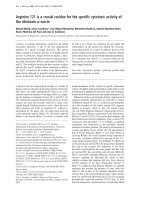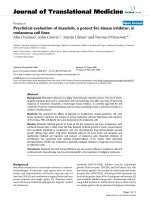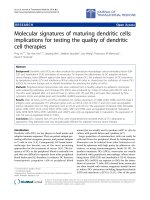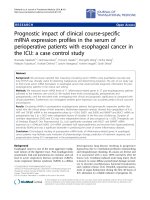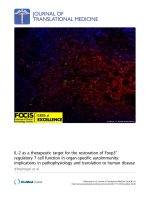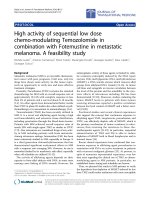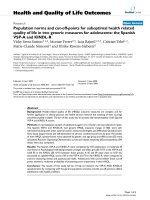báo cáo hóa học:" Biomechanical testing of a polymer-based biomaterial for the restoration of spinal stability after nucleotomy" pptx
Bạn đang xem bản rút gọn của tài liệu. Xem và tải ngay bản đầy đủ của tài liệu tại đây (5 MB, 9 trang )
BioMed Central
Page 1 of 9
(page number not for citation purposes)
Journal of Orthopaedic Surgery and
Research
Open Access
Research article
Biomechanical testing of a polymer-based biomaterial for the
restoration of spinal stability after nucleotomy
Aldemar A Hegewald*
†1
, Sven Knecht
†2
, Daniel Baumgartner
2
, Hans Gerber
2
,
Michaela Endres
3,4
, Christian Kaps
4
, Edgar Stüssi
2
and Claudius Thomé
1
Address:
1
Department of Neurosurgery, Medical Faculty Mannheim, University of Heidelberg, Theodor-Kutzer-Ufer 1-3, 68167 Mannheim,
Germany,
2
Institute for Biomechanics, ETH Zurich, Wolfgang Pauli-Str. 10, 8093 Zürich, Switzerland,
3
Tissue Engineering Laboratory, Department
of Rheumatology, Charité – University Medicine Berlin, Tucholskystrasse 2, 10117 Berlin, Germany and
4
TransTissue Technologies GmbH,
Tucholskystrasse 2, 10117 Berlin, Germany
Email: Aldemar A Hegewald* - ; Sven Knecht - ;
Daniel Baumgartner - ; Hans Gerber - ; Michaela Endres - ;
Christian Kaps - ; Edgar Stüssi - ; Claudius Thomé -
* Corresponding author †Equal contributors
Abstract
Background: Surgery for disc herniations can be complicated by two major problems: painful
degeneration of the spinal segment and re-herniation. Therefore, we examined an absorbable poly-
glycolic acid (PGA) biomaterial, which was lyophilized with hyaluronic acid (HA), for its utility to
(a) re-establish spinal stability and to (b) seal annulus fibrosus defects. The biomechanical properties
range of motion (ROM), neutral zone (NZ) and a potential annulus sealing capacity were
investigated.
Methods: Seven bovine, lumbar spinal units were tested in vitro for ROM and NZ in three
consecutive stages: (a) intact, (b) following nucleotomy and (c) after insertion of a PGA/HA
nucleus-implant. For biomechanical testing, spinal units were mounted on a loading-simulator for
spines. In three cycles, axial loading was applied in an excentric mode with 0.5 Nm steps until an
applied moment of ± 7.5 Nm was achieved in flexion/extension. ROM and NZ were assessed.
These tests were performed without and with annulus sealing by sewing a PGA/HA annulus-implant
into the annulus defect.
Results: Spinal stability was significantly impaired after nucleotomy (p < 0.001). Intradiscal
implantation of a PGA-HA nucleus-implant, however, restored spinal stability (p < 0.003). There
was no statistical difference between the stability provided by the nucleus-implant and the intact
stage regarding flexion/extension movements (p = 0.209). During the testing sequences, herniation
of biomaterial through the annulus defect into the spinal canal regularly occurred, resulting in
compression of neural elements. Sewing a PGA/HA annulus-implant into the annulus defect,
however, effectively prevented herniation.
Conclusion: PGA/HA biomaterial seems to be well suited for cell-free and cell-based regenerative
treatment strategies in spinal surgery. Its abilities to restore spinal stability and potentially close
annulus defects open up new vistas for regenerative approaches to treat intervertebral disc
degeneration and for preventing implant herniation.
Published: 15 July 2009
Journal of Orthopaedic Surgery and Research 2009, 4:25 doi:10.1186/1749-799X-4-25
Received: 1 March 2009
Accepted: 15 July 2009
This article is available from: />© 2009 Hegewald et al; licensee BioMed Central Ltd.
This is an Open Access article distributed under the terms of the Creative Commons Attribution License ( />),
which permits unrestricted use, distribution, and reproduction in any medium, provided the original work is properly cited.
Journal of Orthopaedic Surgery and Research 2009, 4:25 />Page 2 of 9
(page number not for citation purposes)
Background
When implementing regenerative strategies to treat degen-
erative spinal diseases, we have to keep in mind that, ulti-
mately, our main objective is not tissue regeneration, but
the elimination of pain for the patient. In this context, it
is useful to differentiate between preventive and curative
treatment approaches [16]. Hence, each approach has its
particular clinical indications and needs to address spe-
cific disease-related problems in order to be beneficial for
the patient.
In spinal surgery, preventive procedures to avoid common
follow-up complications are conceivable in operations for
disc herniation with predominant radicular leg pain.
Here, surgery is done for neural decompression. The ini-
tial success rate is high: up to 92% report a good or excel-
lent outcome after 4 to 6 months following surgery [34].
But in the long-term follow-up, intervertebral disc hernia-
tions can be complicated by two major problems: (a)
painful de-generation of the spinal segment
[23,37,24,4,5], and (b) re-herniation [10,5,6]. Thus, it is
reasonable to think about possible interventions during
primary surgery to avoid these complications.
Taking a closer look at these complications, painful
degeneration of the spinal segment after surgery for
intervertebral disc herniation can be found in up to 47%
of the patients after 2 years follow-up and correlates with
pathological modic changes in the adjacent vertebral bod-
ies [5,6]. Atlas et al. reported that after 10 years, 31% com-
plain about back pain with the same intensity or worse
than shortly before operation [4]. In the literature, three
major causes for the development of pain are suggested:
(1) segmental spinal instabilities and pathological load-
ing patterns, caused by preceding degeneration and the
operation itself [26,8,21,33,28,31,3], (2) pathological
ingrowths of nerves into the inner layers of the torn annu-
lus fibrosus, sometimes even penetrating the nucleus pul-
posus [13,29,30] and (3) pain-mediating inflammatory
cytokines like TNF-alpha and IL-1 secreted by disc cells
and granulation tissue [9,25].
Re-herniation occurs predominately within the first two
years after surgery. From our own data, we can report a re-
operation rate of approximately 10% after a mean of 9
months because of re-herniation [5]. Moreover, re-opera-
tion rates up to 21% have been reported with annulus
fibrosus defects larger than 6 mm [10]. Especially in the
context of nucleus implants, defects larger than 6 mm will
regularly occur due to access-related enlargement of the
defect and post a considerable safety problem.
Current regenerative approaches for the biological repair
of intervertebral disc tissue to prevent painful degenera-
tion of the spinal segment focus on the transplantation of
culture-expanded, autologous, disc-derived cells. A first
clinical trial indicates that this approach reduces back
pain and may prevent loss of disc height [22]. More
advanced tissue engineering approaches focus on the use
of absorbable biomaterials combined with autologous
cells and/or bioactive factors [16]. The use of biomaterials
potentially improves biomechanical properties, allows
even distribution of cells and may guide tissue formation
and regeneration [32].
Recently, it has been shown that cell-free PGA/HA bioma-
terial, immersed in autologous serum, induced the regen-
eration of articular cartilage in a sheep model [12]. Most
interesting, in a rabbit model of disc degeneration,
intradiscal implantation of cell-free PGA/HA nucleus-
implant facilitates the formation of superior nucleus pul-
posus repair tissue and the reduction of the loss of disc
height compared to a control group [1]. With an aim
toward disc regeneration based on polymer-based
implants, we biomechanically analyzed the feasibility of a
biointegrative, absorbable PGA/HA biomaterial for its
utility to (a) re-establish initial spinal stability by being
inserted as a nucleus-implant and to (b) seal annulus
fibrosus defects by being sewed in as an annulus-implant.
Methods
Sample Preparation
We obtained four intact frozen lumbar spines of calves,
aged between 12 and 18 weeks, from the Institute of Vet-
erinary Pathology at the University of Zurich. Literature
has shown that no significant differences in range of
motion are detected between bovine and human speci-
mens considering flexion/extension movements [18]. The
samples were frozen at -20°C until the day of testing
when they were thawed overnight in a refrigerator at 4°C.
Seven intact functional lumbar units (L1/L2 and L4/L5)
were prepared from the spines without destruction of the
ligaments, capsules and soft tissue.
Soft tissue was only removed from the upper half of the
cranial vertebral body and the lower half of the caudal ver-
tebral body. The upper and lower vertebrae were embed-
ded in acrylic resin (Beracryl, Suter-Swiss composite
Group, Fulenbach, Switzerland) to ensure fixation while
testing. During preparation and testing, the samples were
covered with PBS-soaked tissue and wrapped in plastic
film.
Preparation and Implantation of the Spinal Units
Preparation was performed according to the same stand-
ard microsurgery procedure used in our neurosurgical
department. In brief, the spinal canal was exposed by per-
forming a minimal interlaminar fenestration. Thus, mini-
mal removal of bone and articular structures was
achieved. Nucleotomy was performed after scalpel inci-
Journal of Orthopaedic Surgery and Research 2009, 4:25 />Page 3 of 9
(page number not for citation purposes)
sion of the annulus fibrosus. Resection of nucleus pulpo-
sus tissue from the intervertebral space was performed
with a 5 mm rongeur. Curettes were not used, and injury
to the cartilaginous endplates was avoided. This proce-
dure resulted in an annulus defect of approximately 5 mm
× 5 mm.
Before implantation of the cell-free PGA/HA nucleus-
implant, it was immersed in isotonic saline solution.
Then, it was inserted through the annulus defect into the
nucleus pulposus compartment. 8 to 12 pieces of 10 × 15
× 1.1 mm were inserted and equally distributed within the
compartment.
For implantation of the annulus sealing system, the PGA/
HA annulus-implant with a size of 15 mm × 10 mm was
affixed with 4 sutures (Polysorb 3-0, Syneture) in an
inside-out-technique to the inner wall of the annulus
fibrosus in 4 specimens (Fig. 1). For that purpose, four
sutures were pre-fixed at the corners of the implant. The
sutures were threaded from the inside to the outside of the
annulus, penetrating the annulus close to the vertebral
endplates. Thereupon, the implant was roped into the
annulus defect and attached to the inner wall of the annu-
lus fibrosus. The sutures were then fixated by surgical
knots at the outer surface of the annulus.
Mechanical Loading Simulator
To assess the functional behavior of the spinal segments,
they were tested under flexion/extension as well as left/
right-bending in a mechanical loading simulator (Fig. 2).
The lower part of the spinal unit (L2 and L5, respectively)
was fixed on an x-y table, which was attached to a material
testing machine (Zwick Z2.5, Zwick, Ulm, Germany) with
a 1000 N load cell (KAP-S, Angewandte System Technik
AST, Woln-zach, Germany). Biomechanical testing of the
segments was performed by eccentric load introduction
according to Adams et al. [2], resulting in constrained flex-
ion/extension movement. The position of the center of
rotation (COR) was assumed to be 1 cm ventral of the
dorsal rim of the vertebral body [2]. Load was applied in
steps of 25 N at 2 cm anterior and posterior from the COR
Fixation techniqueFigure 1
Fixation technique. Schematic illustration showing the anchorage of the PGA-HA annulus-implant in the annulus defect.
Four sutures are pre-fixed at the corners of the implant. With an inside-out-technique the implant is attached to the inner wall
of the annulus fibrosus. Ideally, the suture penetrates the annulus close to the vertebral endplate. The sutures are then fixated
by surgical knots at the outer surface of the annulus.
Journal of Orthopaedic Surgery and Research 2009, 4:25 />Page 4 of 9
(page number not for citation purposes)
up to a final external load of 375 N, resulting in a maximal
moment of 7.5 Nm and back to 0 N. To assess the result-
ing movements of the vertebrae, Kirschner wires with
reflecting markers were fixed at each of the vertebrae (Fig.
2). The markers were tracked using a 4-camera Vicon
motion capture system (Vicon MX 612, Oxford Metrics,
Oxford, UK) at 30 Hz. Accuracy of marker center location
has been determined to be within ± 1/3 mm. Flexion/
extension angles were calculated from the movement of
the markers projected on the sagittal plane using Matlab
(MathWorks, Massachusettes, USA).
The samples were tested consecutively (1) intact, (2) after
nucleotomy and (3) after insertion of the PGA/HA
nucleus-implant with and without sealing of the annulus
defect. After an axial position-controlled preload of 300N
applied for 15 min, each sample was tested in flexion/
extension and left/right-bending – under each condition,
3 times. The resulting range of motion (ROM) and the
neutral zone (NZ) according to Panjabi et al. [27] was cal-
culated from the third cycle from the moment-rotation
curves (Fig. 3) and normalized by dividing the individual
value by the results of the intact samples. ROM and NZ are
displayed as median value.
Statistical Analysis
For statistical analysis, ROM and neutral zone (NZ) data
were analyzed for normal distribution. Since the data
showed no normal distribution, the non-parametric
Mann-Whitney rank sum test was applied and differences
were considered significant at p < 0.05. ROM and NZ are
given as median values. The ends of the boxes define the
25th and 75th percentiles, with a line at the median and
error bars defining the 10th and 90th percentiles.
Results
Nucleotomy was performed by a standard microsurgical
interlaminar approach. Intradiscal implantation of the
PGA-HA nucleus-implant as well as sealing of the annulus
defect by sewing a PGA-HA annulus-implant into the
defect in an inside-out-technique was achieved by the
same microsurgical interlaminar access.
Range of motion (ROM) and neutral zone (NZ)
Range of motion was significantly increased in flexion/
extension after nucleotomy (ROMflex/ext: 125.3%, p <
0.001). Intradiscal implantation of PGA-HA nucleus-
implant, however, restored spinal stability (ROMflex/ext:
108.8%, p < 0.003). There was no statistical difference
between the ROM provided by the nucleus-implant and
the intact stage regarding flexion/extension movements (p
= 0.209) (Fig. 4). Left/right-bending, however, was not
significantly impaired by nucleotomy but a trend in con-
straining ROM was observed after implantation of the
nucleus-implant (data not shown). The neutral zone in
flexion/extension was significantly increased after nucle-
otomy (NZ flex/ext: 134.5%; p < 0.006) (Fig. 4). After
implantation of the nucleus-implant, there was not statis-
tical difference in the NZ (NZ flex/ext: 121.5%; p = 0.209).
However, analyzing all samples individually revealed a
trend toward reduction of the NZ in every single sample
with implantation of the PGA-HA nucleus-implant.
Test set-upFigure 2
Test set-up. Spinal segment in a mechanical loading simulator (A). To assess the resulting movements of the vertebrae, Kir-
schner wires with reflecting markers were fixed at each dorsal process. The markers were tracked using a 4-camera vicon
motion capture system (B).
Journal of Orthopaedic Surgery and Research 2009, 4:25 />Page 5 of 9
(page number not for citation purposes)
Momentum-rotation-curves illustrate the response to flex-
ion/extension in intact, nucleotomized and implanted
spinal segments (Fig. 3).
Annulus Sealing
During the testing sequences, herniation of the PGA-HA
nucleus-implant through the annulus defect into the spi-
nal canal occurred in all 3 unsealed specimens, resulting
in compression of neural elements (Fig. 5AB). Sewing a
PGA-HA annulus-implant into the annulus defect, how-
ever, effectively prevented herniation in all 4 sealed speci-
mens (Fig. 5C). Because of pressure from the nucleus
compartment during the testing sequences, the PGA-HA
annulus-implant bulged into the annulus defect without
compromising the spinal canal with its neural structures.
Discussion
Recent advances in regenerative medicine have led to
promising new approaches for the biological treatment of
disc degeneration. Treatment modalities include the
administration of growth factors, the application of autol-
ogous or allogenic cells, gene therapy, in situ therapy and
the introduction of biomaterials or a combination thereof
[16]. Promising experimental results in vitro and in ani-
mal studies support the potential feasibility of these treat-
ment modalities in clinical studies.
For a preventive approach during surgery for interverte-
bral disc herniation, immediate restoration of spinal sta-
bility is most likely the key issue. Since tissue generation
takes time, the use of a suitable biomaterial that provides
Moment-rotation curvesFigure 3
Moment-rotation curves. Typical moment-rotation curves of the intact specimen (line), after nucleotomy (dotted) and after
PGA implant insertion (dash-dotted) for 4 segments (samples 4–7).
Journal of Orthopaedic Surgery and Research 2009, 4:25 />Page 6 of 9
(page number not for citation purposes)
initial spinal stability and, at the same time, promotes tis-
sue generation, is of importance.
In a bovine model that showed a comparable ROM to the
human spine in previous works [35], Wilke et al. were
able to restore spinal stability after nucleotomy using a
condensed collagen type-I matrix [36]. However, during
biomechanical testing, herniation of the collagen bioma-
terial was noted in 50% of the cases. It could not be pre-
vented by suturing the annulus defect or gluing it with
fibrin- or acryl-glue [17]. This confirms the major prob-
lem of most nucleus implants. Likewise, efforts to restore
spinal stability by replacing the morbid nucleus pulposus
with artificial compounds, such as, hydrogels, protein
polymers and elastomers [11,7] demonstrated high com-
plication rates, mainly because of implant migration [19].
Furthermore, there are concerns about the long-term con-
sequences of implanting inert artificial materials into
intervertebral disc space, which is subject to age-related
biomechanical and biological changes.
In this work, we present an absorbable PGA-HA biomate-
rial that had been shown to promote the generation of
disc-like tissue in vitro with mesenchymal stem cells [14],
nucleus pulposus cells [15] and in a rabbit model [1]. To
further qualify as a suitable nucleus-implant for clinical
application, biomechanical studies were mandatory.
Therefore, we determined the range of motion (ROM)
and the neutral zone (NZ) of the spinal unit to assess its
functional behavior after implantation of the biomaterial.
ROM describes the maximal possible rotation, whereas
the neutral zone is a common parameter to reflect the
degree of laxity in the neutral region of spinal movement
[27].
Nucleotomy significantly increased the ROM and NZ in
all samples and consequently impairs the stability of the
spine. The investigated PGA-HA nucleus-implants, how-
ever, were able to restore biomechanical characteristics of
the spinal segments in flexion/extension. Similar to the
collagen type-I implants, tested by Wilke et al. [36]; ROM
was restored for the sample group, whereas the NZ
showed only a trend toward restoration. The individual
NZ for all 7 samples, however, were restored to values
similar to the intact spinal segments. Thus, implantation
of the PGA-HA biomaterial has the capability to restore
the individual bio-mechanical behavior (ROM and NZ) in
flexion/extension. Additionally performed lateral bend-
ing tests showed only a trend toward restoring ROM after
implantation of PGA-HA biomaterial (data not shown).
In contrast to Wilke et al., where the annulus was
approached from laterally, we performed a microsurgical
dorsal approach, commonly utilized for lumbar disc her-
niations. With this standard approach, lateral parts of the
annulus and even lateral aspects of the nucleus potentially
remain in situ, as can be suspected by unaffected clinical
re-herniation rates after nucleotomy compared to seques-
trectomy [5]. This might explain our non-significant
Statistical analysis of ROMFigure 4
Statistical analysis of ROM. Statistical analysis of ROM of intact disc specimen, after nucleotomy and after implantation of
the PGA-HA nucleus-implant using the Mann-Whitney Rank Sum Test. The ends of the boxes define the 25th and 75th percen-
tiles, with a line at the median and error bars defining the 10th and 90th percentiles.
Journal of Orthopaedic Surgery and Research 2009, 4:25 />Page 7 of 9
(page number not for citation purposes)
results in lateral bending. Previous works suggest that
rotational stability is mostly affected by the structural
integrity of the annulus fibrosus [36]. Since axial rotation
may not be a reliable parameter for a nucleus-implant it
was not performed in this preliminary study. A limitation
of the study was the constrained loading condition, under
which shear loads cannot be induced to the spinal seg-
ments, as observed in vivo. Nevertheless, this simplified
quasistatic testing approach allows to compare changes in
the primary mechanical stability of the spinal segment
after nucleotomy and after the implantation as well as to
assess the initial maximal stability of this implant to pre-
vent herniation. Similar to Wilke et al. [36], we observed
herniation of the biomaterial in all unsealed samples just
after 3 loading cycles, resulting in compression of neural
structures. Therefore, although biocompatibility, regener-
ative potential and biomechanical characteristics are very
promising, clinical application can only be considered
when an appropriate annulus sealing system has been
developed.
Recently, some annulus closure techniques for avoiding
re-herniation have been introduced to the market, with
interesting first clinical results [20]. In combination with
biomaterials, these techniques might prove to be useful
for regenerative treatment strategies. But again, implant-
ing artificial solid materials gives rise to concerns about
implant migration with potential serious complications.
Here, we introduce an annulus sealing system that can be
applied through a standard microsurgical inter-laminar
approach. Sewing a PGA-HA annulus-implant into the
annulus defect prevented herniation of biomaterial into
the spinal canal. However, these are just preliminary
results, since only a limited number of cycles and no shear
loads were applied to the annulus. Before clinical use, the
effect of cycle fatigue loading upon the sealed specimens
needs to be studied to investigate whether sewing a PGA-
HA annulus-implant into the annulus defect effectively
prevents herniation. Moreover, the suitability of the fixa-
tion technique in highly degenerated discs needs to be
verified. Besides providing initial nucleus containment,
the annulus sealing system is supposed to promote and
enhance the generation of a functional surrogate tissue
before it is completely absorbed. Here, as with the PGA-
HA nucleus-implant, a combination with disc cells, stem
cells and/or bioactive factors is conceivable. We believe
this technique will be of relevance for future applications
of regenerative and solid nucleus implants. Moreover, a
stand-alone use after sequestrectomy or nucleotomy
might significantly lower re-herniation incidences of
intervertebral disc herniations.
Conclusion
PGA/HA biomaterial seems to be well suited for cell-free
and cell-based regenerative treatment strategies in spinal
Macroscopic evaluationFigure 5
Macroscopic evaluation. Herniated biomaterial impress-
ing the dural sack from a lateral view after removing the facet
joints (A). Dorsal view after removing posterior vertebral
structures, showing herniated biomaterial into the spinal
canal (B) und successful sealing of the annulus defect with a
PGA-HA annulus implant (C).
Journal of Orthopaedic Surgery and Research 2009, 4:25 />Page 8 of 9
(page number not for citation purposes)
surgery. Its abilities to restore spinal stability and poten-
tially close annulus defects open up new vistas for regen-
erative approaches to treat intervertebral disc
degeneration and for preventing implant herniation.
Competing interests
CK and ME are employees of TransTissue Technologies
GmbH (Berlin, Germany). The other authors declare that
they have no additional competing interests.
Authors' contributions
AAH invented the annulus sealing system and developed
adequate surgical techniques for the application of the
nucleus and annulus implants.
SK participated in the design of the study and conceived
of the biomechanical test set-up.
DB carried out the biomechanical testing routines and
contributed to the analysis of the data.
HG gave substantial input to realize the biomechanical
test set-up and advised in analyzing the data.
ME advised about the use of biomaterials and customized
the PGA-HA biomaterial.
CK participated in the design of the study and performed
the statistical analysis.
ES participated in the design and coordination of the
study and helped to draft the manuscript.
CT supervised study design and implant development in
the context of meeting clinical requirements and helped
to draft the manuscript.
Acknowledgements
The study was supported by the Federal Ministry of Education and
Research (BioInside 13N9831 & 13N9827) and the Investitionsbank Berlin
and the European Regional Development Fund (DiscTissue 10138665).
References
1. Abbushi A, Endres M, Cabraja M, Kroppenstedt SN, Thomale UW,
Sittinger M, Hegewald AA, Morawietz L, Lemke AJ, Bansemer VG,
Kaps C, Woiciechowsky C: Regeneration of intervertebral disc
tissue by resorbable cell-free polyglycolic acid-based
implants in a rabbit model of disc degeneration. Spine 2008,
33:1527-1532.
2. Adams MA: Mechanical testing of the spine. An appraisal of
methodology, results, and conclusions. Spine 1995,
20:2151-2156.
3. An HS, Masuda K, Inoue N: Intervertebral disc degeneration:
biological and biomechanical factors. J Orthop Sci 2006,
11:541-552.
4. Atlas SJ, Keller RB, Wu YA, Deyo RA, Singer DE: Long-term out-
comes of surgical and nonsurgical management of sciatica
secondary to a lumbar disc herniation: 10 year results from
the maine lumbar spine study. Spine 2005, 30:927-935.
5. Barth M, Weiss C, Thomé C: Two-year outcome after lumbar
microdiscectomy versus microscopic sequestrectomy: part
1: evaluation of clinical outcome. Spine 2008, 33:265-272.
6. Barth M, Diepers M, Weiss C, Thomé C: Two-year outcome after
lumbar microdiscectomy versus microscopic sequestrec-
tomy: part 2: radiographic evaluation and correlation with
clinical outcome. Spine 2008, 33:273-279.
7. Boyd LM, Carter AJ: Injectable biomaterials and vertebral end-
plate treatment for repair and regeneration of the interver-
tebral disc. Eur Spine J. 2006, 15(Suppl 3):S414-S421.
8. Brinckmann P, Grootenboer H: Change of disc height, radial disc
bulge, and intradiscal pressure from discectomy. An in vitro
investigation on human lumbar discs. Spine 1991, 16:641-646.
9. Burke JG, Watson RW, McCormack D, Dowling FE, Walsh MG, Fit-
zpatrick JM: Intervertebral discs which cause low back pain
secrete high levels of proinflammatory mediators. J Bone Joint
Surg Br 2002, 84:196-201.
10. Carragee EJ, Han MY, Suen PW, Kim D: Clinical outcomes after
lumbar discectomy for sciatica: the effects of fragment type
and anular competence. J Bone Joint Surg Am
2003, 85-A:102-108.
11. Di Martino A, Vaccaro AR, Lee JY, Denaro V, Lim MR: Nucleus pul-
posus replacement: basic science and indications for clinical
use. Spine (Phila Pa 1976). 2005, 30(16 Suppl):S16-S22.
12. Erggelet C, Neumann K, Endres M, Haberstroh K, Sittinger M, Kaps
C: Regeneration of ovine articular cartilage defects by cell-
free polymer-based implants. Biomaterials 2007, 28:5570-5580.
13. Freemont AJ, Peacock TE, Goupille P, Hoyland JA, O'Brien J, Jayson
MI: Nerve ingrowth into diseased intervertebral disc in
chronic back pain. Lancet 1997, 350:178-181.
14. Hegewald AA: Potential of mesenchymal stem cells for chon-
drogenic differentiation in high-density-3D-cultures and in
bioresorbable polymer fleece. 2006 [-ber
lin.de/diss/receive/FUDISS_thesis_000000001925].
15. Hegewald AA, Endres M, Sittinger M, Kaps C, Thomé C: Polymer-
based Regenerative Treatment Strategies in Spinal Surgery:
Engineering Biocompatible Nucleus Pulposus Grafts. Eur
Spine J 2007, 16:. 1976 (V 31)
16. Hegewald AA, Ringe J, Sittinger M, Thome C: Regenerative treat-
ment strategies in spinal surgery. Front Biosci 2008,
13:1507-1525.
17. Heuer F, Ulrich S, Claes L, Wilke HJ: Biomechanical evaluation of
conventional anulus fibrosus closure methods required for
nucleus replacement. Laboratory investigation. J Neurosurg
Spine 2008, 9:307-313.
18. Kettler A, Liakos L, Haegele B, Wilke HJ: Are the spines of calf, pig
and sheep suitable models for pre-clinical implant tests? Eur
Spine J 2007, 16:2186-2192.
19. Klara PM, Ray CD: Artificial nucleus replacement: clinical
experience. Spine 2002, 27:1374-1377.
20. Luggin J, Eustacchio S, Trummer , Kamaric E, Lambrecht G: The Bar-
ricaidTM-prosthesis: An implant for closure of anular defects
in lumbar discs: Preliminary clinical experience. Eur Spine J
2006, 15:1561-1632. (Abstract 90)
21. McNally DS, Shackleford IM, Goodship AE, Mulholland RC: In vivo
stress measurement can predict pain on discography. Spine
1996, 21:2580-2587.
22. Meisel HJ, Ganey T, Hutton WC, Libera J, Minkus Y, Alasevic O: Clin-
ical experience in cell-based therapeutics: intervention and
outcome. Eur Spine J. 2006, 15(Suppl 3):397-405.
23. Mochida J, Nishimura K, Nomura T, Toh E, Chiba M: The impor-
tance of preserving disc structure in surgical approaches to
lumbar disc herniation. Spine 1996, 21:1556-1563.
24. Mochida J, Toh E, Nomura T, Nishimura K: The risks and benefits
of percutaneous nucleotomy for lumbar disc herniation. A
10-year longitudinal study. J Bone Joint Surg Br 2001, 83:
501-505.
25. Mulleman D, Mammou S, Griffoul I, Watier H, Goupille P: Patho-
physiology of disk-related sciatica. I. Evidence supporting a
chemical component. Joint Bone Spine 2006, 73:151-158.
26. Panjabi MM, Krag MH, Chung TQ: Effects of disc injury on
mechanical behavior of the human spine. Spine 1984,
9:707-713.
27. Panjabi MM: The stabilizing system of the spine. Part II. Neu-
tral zone and instability hypothesis. J Spinal Disord 1992,
5:390-396.
28. Panjabi MM: Clinical spinal instability and low back pain. J Elec-
tromyogr Kinesiol 2003, 13:371-379.
Publish with BioMed Central and every
scientist can read your work free of charge
"BioMed Central will be the most significant development for
disseminating the results of biomedical research in our lifetime."
Sir Paul Nurse, Cancer Research UK
Your research papers will be:
available free of charge to the entire biomedical community
peer reviewed and published immediately upon acceptance
cited in PubMed and archived on PubMed Central
yours — you keep the copyright
Submit your manuscript here:
/>BioMedcentral
Journal of Orthopaedic Surgery and Research 2009, 4:25 />Page 9 of 9
(page number not for citation purposes)
29. Peng B, Wu W, Hou S, Li P, Zhang C, Yang Y: The pathogenesis of
discogenic low back pain. J Bone Joint Surg Br 2005, 87:62-67.
30. Peng B, Hao J, Hou S, Wu W, Jiang D, Fu X, Yang Y: Possible patho-
genesis of painful intervertebral disc degeneration. Spine
2006, 31:560-566.
31. Pollintine P, Dolan P, Tobias JH, Adams MA: Intervertebral disc
degeneration can lead to "stress-shielding" of the anterior
vertebral body: a cause of osteoporotic vertebral fracture?
Spine 2004, 29:774-782.
32. Sittinger M, Hutmacher DW, Risbud MV: Current strategies for
cell delivery in cartilage and bone regeneration. Curr Opin Bio-
technol 2004, 15:411-418.
33. Sizer PS, Phelps V, Matthijs O: Pain generators of the lumbar
spine. Pain Pract 2001, 1:255-273.
34. Thomé C, Barth M, Scharf J, Schmiedek P: Outcome after lumbar
sequestrectomy compared with microdiscectomy: a pro-
spective randomized study. J Neurosurg Spine 2005, 2:271-278.
35. Wilke HJ, Krischak S, Claes L: Biomechanical comparison of calf
and human spines. J Orthop Res 1996, 14:500-503.
36. Wilke HJ, Heuer F, Neidlinger-Wilke C, Claes L: Is a collagen scaf-
fold for a tissue engineered nucleus replacement capable of
restoring disc height and stability in an animal model? Eur
Spine J. 2006, 15(Suppl 3):S433-S438.
37. Yorimitsu E, Chiba K, Toyama Y, Hirabayashi K: Long-term out-
comes of standard discectomy for lumbar disc herniation: a
follow-up study of more than 10 years. Spine 2001, 26:652-657.

